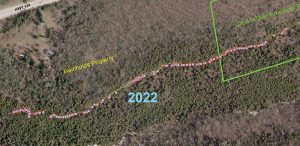Climbing access in ‘protection areas’ granted without explanation
The Ministry of the Environment, Conservation and Parks is exploring options to authorize rock climbing at Devil’s Glen Provincial Park after being lobbied by the Ontario Alliance of Climbers (OAC), despite scientific data collected by park staff that shows the activity has an impact on the ecologically sensitive cliffs.
Because rock climbing is not currently included in the Devil’s Glen Provincial Park Management Plan it is not a sanctioned use, however rock climbers continue to push for access.
The OAC is a volunteer-run organization that is campaigning for an amendment to management plans to allow rock climbing – which is forbidden in almost all Ontario Provincial Parks and much of the Niagara Escarpment – through a ‘Climb in Parks’ campaign targeted at the minister’s office.
At Devil’s Glen, where provincial park staff has turned a blind eye to climbing in the past, there has been a significant number of climbing routes developed in the park over the past several years without any environmental review or approval by park managers.
Ontario Parks communicated to the OAC as far back as 2015 that ongoing unauthorized climbing route development in provincial parks is not permitted, however climbing has continued to expand.
Rock climbing at Devils’ Glen occurs within the park boundary and on adjacent land owned by the Ministry of Natural Resources and Forestry (MNRF) known as the Reinhold Property, which was acquired with the intention of rolling it into the park. The objective is to protect the significant natural values within the park boundary and adjacent crown land.
Research and monitoring has indicated that areas along the Niagara Escarpment experience slow ecological recovery and the cliffs support the least disturbed and oldest forest ecosystem in North America. Devil’s Glen Provincial Park, a provincial Area of Natural and Scientific Interest (ANSI), contains a portion of the Mad River Valley, the largest incised gorge in the eco-district.
The increase in climbing development is impacting the provincially significant and rare species that live on the cliff face. Results of an ecological values survey of bolted routes found that rock climbing impacts the small cracks and crevices where high value plants grow, including the native Smooth Cliff Brake and uncommon Green Spleenwort Fern, along with a host of rare micro snails, birds and bats that inhabit the cliffs. The inventory shows reduced vegetation present on the popular climbing routes.
Park staff found evidence of limbs being cut from old-growth cedars at the top of the cliff, a sawed off tree halfway up the cliff, uprooted plants, a crevice cave containing recreational garbage relating to rock climbing and the introduction of invasive species such as Garlic Mustard.
Ecologist Ron Gould, Ontario Parks’ Protection Areas Specialist for the southwest zone, reports (in a 2022 email obtained through a Freedom of Information (FOI) request) noticing an accelerated number of new climbing routes being developed within Devil’s Glen Provincial Park and the adjacent Reinhold property, including more bolted route development through the winter. He expresses frustration at attempting to conduct an ecological values survey on a “moving target” as new routes were popping up on areas recently inventoried.
“I am worried that this is related to knowledge of our ongoing cliff values survey and the general push to get more routes developed before any formal climbing management in the area,” writes Gould. “Some of the new routes are going in locations of rare and sensitive cliff species that the lands were acquired to protect.”
In 2021, The Echo was told that Ontario Parks was focussed on educating rock climbers and reducing the number of bolted routes. Park staff said rock climbing at Devil’s Glen, a recreation class park, is not expressly prohibited but is not promoted. Despite claims that rock climbing is a historic use of the park, staff has been unable to locate any evidence of this in their records.
Back in 2019, the OAC was telling its members not to develop new routes at Devil’s Glen and Lion’s Head, however mapping shows a significant increase in the number of routes at Devil’s Glen and the Reinhold Property between 2014 and 2022.
In 2022, Ontario Parks erected ‘no rock bolting’ signs in an effort to halt route development. Then, in May of 2023, new signs were installed identifying three ecologically sensitive protection areas where climbing was restricted due to the presence of rare cliff ferns, bat roosting features and cliff nesting birds. The signage was installed to notify people that the areas should not be disturbed in order to protect the most sensitive ecological values at Devil’s Glen.
Once the minister’s office got involved, climbing access to the ecologically sensitive areas was granted without explanation, and park staff went mum.
The protection zones impacted access to 24 of the 140 routes in the vicinity that are published on climbing websites and are promoted within the rock climbing community.
While the signs went up without any warning to the OAC, they came down just as quickly and without explanation.
When The Echo asked what had changed, park staff evaded requests for an interview. Requests to the minister’s office also went unanswered, and instead a vague statement was issued: “The Government of Ontario believes Ontario Parks are places where recreational activity should be encouraged. The Ministry of Environment, Conservation and Parks has been working with the Ontario Alliance of Climbers to support safe rock climbing opportunities. We are pleased to welcome rock climbers back to Devil’s Glen and Lion’s Head Provincial Parks and the Minister looks forward to working with rock climbers on expanding opportunities to enjoy their sport in Ontario Parks soon.”
Given that rock climbers had not been barred from Devil’s Glen, we found the statement unsatisfactory and proceeded to file a request for information through the Freedom of Information and Protection of Privacy Act (FIPPA). The request was filed in August of last year but it wasn’t until November that The Echo received a package of heavily redacted documents. It was then revealed that the record search had not been thorough and only after an appeal to the Information and Privacy Commissioner of Ontario was a more transparent package received this month.
Hundreds of pages of redacted e-mails and meeting minutes reveal that members of the OAC said they were “disturbed” by the installation of the signs in May, which strained a collaborative relationship between the OAC and Ontario Parks.
“If this is official signage, this is a statement by Ontario Parks that there is no longer any interest in ongoing communication, or a consultative relationship with the climbing community,” wrote OAC co-chair Mike Penney.
At the May meeting between the OAC and Ontario Parks, the minutes show that Greg Wilson, manager for the southwest zone, acknowledged that communication about the signs could have been improved and that Ontario Parks wants to work towards a sustainable future with the OAC.
The OAC set about “building a strategy” to counter the closure and the minister’s office intervened after lobbying from members of the climbing community, which included a letter writing campaign. At the OAC’s November AGM they reported soliciting more than 3,000 letters to the minister.
They worked with a lobbyist and “made good relationships with the ministry” reported OAC volunteer Dustin Johnston-Jewell.
The documents outline a turf war of sorts happening in the hidden valley. As climbing activity increased, resident complaints were received about parking, garbage, impact on the cliffs, harassment, trespassing on private property.
Each time signs were installed they would be stolen or altered.
At one point bolted routes were vandalized, the bolts cut using a grinder.
Trees and brush were used to block paths and no-bolting messages were spray painted on rocks.
In July, a representative from the minister’s office attended a regular meeting between the OAC and Ontario Parks where it was recorded that “the minister would like to proceed with permitting and authorizing rock climbing at Lion’s Head and Devil’s Glen provincial parks.”
“The ministry, Ontario Parks and the OAC are now working in collaboration to put climbing plans in place for Devil’s Glen and Lion’s Head as a start but ideally all provincial parks eventually, with the primary objective of making sure that there is a good balance between recreational opportunity for Ontarians, conservation of parks – which is obviously an important factor – and the economic benefits that climbing can bring to the local communities,” said Johnston-Jewell at the AGM. “It’s a win-win-win for parks, climbers, for all Ontarians as we work toward management plans.”
Penney refuted evidence that rock climbing is detrimental and said the activity can be done sustainably.
“We can get to a point where we’re working with Ontario Parks to build the resources that are necessary in the parks to make it as sustainable as possible,” said Penney.
Johnston-Jewell said that proper management plans result in compliance. “That’s been shown time and time again in many places,” he said. “My hope is that by working with the parks and the ministry we can get management plans in place that ensure that the amount of development is appropriate in consultation with the park… By legitimizing climbing in the parks and having proper signage and communication and engagement between the stakeholders and between the authority bodies like Ontario Parks and the ministry, we can educate people properly so they know what they can and cannot do. That is 100 per cent the goal.”


